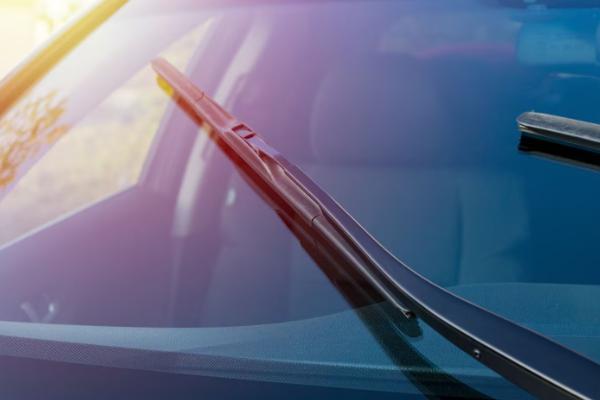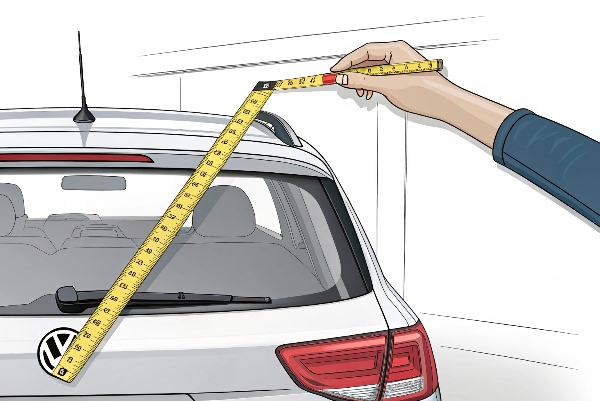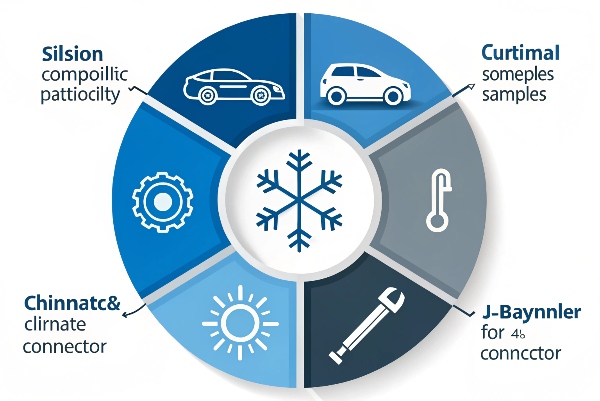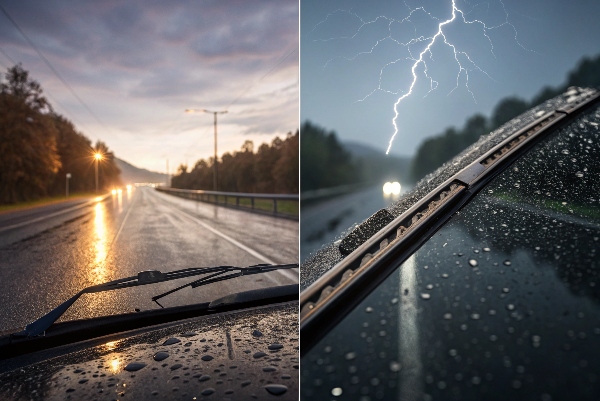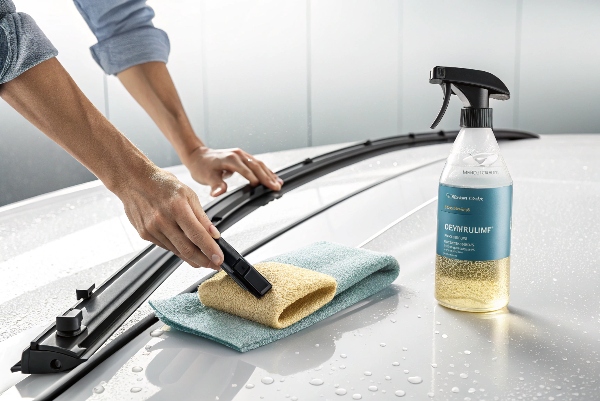2025 Ultimate Guide to Rear Wiper Blades: Install & Care
Sep 23,2025
I remember the first time I drove through a heavy downpour in Xiamen. Rain hammered the rear window, but my wiper blade skipped and streaked. Visibility dropped fast. That frustration taught me a hard lesson. Poor wiper blades can turn safe drives into risks.
The right rear wiper blade fits your vehicle perfectly, matches your climate, and uses quality materials. It clears water without streaks or noise. Start by measuring your arm length, check compatibility, and pick durable rubber or silicone. This simple choice boosts safety and saves money on replacements.
Rear Wiper Blade Selection Guide
You now know the basics to pick a good blade. But details matter more. Let’s dive into measuring size first. This step avoids common mistakes I see in my business every day.
How to Measure the Perfect Rear Wiper Blade Size for Your Vehicle?
Ever grabbed the wrong size blade and watched it flop around? It scrapes poorly and stresses your wiper motor. I once shipped mismatched sizes to a US wholesaler. They sent them back fast. That error cost time and trust.
Measure from the wiper arm’s attachment point to the tip. Most rear blades run 10 to 16 inches. Check your owner’s manual or use online tools for exact specs by make, model, and year. This ensures full coverage without gaps or overhang.
Measuring Rear Wiper Blade
Why Accurate Measurement Matters
Size fits like a glove. Too short, and dirt builds up in corners. Too long, and it hits the window trim. In my 15 years at TOPEX, I’ve seen this cause 20% more returns from e-commerce buyers. Always double-check.
Tools You Need
Grab a tape measure or ruler. Some vehicles list sizes on the blade itself. For tricky ones, like curved rear windows on SUVs, use a flexible string then straighten it.
Step-by-Step Measuring Process
- Park on level ground. Turn off the engine.
- Lift the wiper arm away from the glass.
- Extend the arm fully. Note any stops.
- Measure from the pivot point to the rubber tip. Include the full sweep length.
- Compare to your manual. Apps like WiperSize.com help too.
| Vehicle Type | Common Rear Size Range | Example Models |
|---|---|---|
| Sedans | 10-12 inches | Toyota Camry, Honda Accord |
| Hatchbacks | 12-14 inches | Volkswagen Golf, Ford Focus |
| SUVs | 14-16 inches | Jeep Wrangler, Ford Explorer |
| Trucks | 12-16 inches | Ram 1500, Chevy Silverado |
This table covers North American and European favorites. We stock these at TOPEX for quick shipping to wholesalers.
Common Pitfalls to Avoid
People often guess. Don’t. A half-inch off ruins performance. In rainy UK winters, imprecise sizes lead to fogged views. Test fit if possible. For marine suppliers, who need corrosion-proof blades, exact size prevents leaks in salt air.
Pro Tip from Experience
I once helped a Florida shipbuilder. Their boat’s rear wiper arm measured 14 inches, but curves added flex. We custom-cut a silicone blade. It lasted two seasons in UV hell. Measure twice, order once.
Integrating with Vehicle Specs
Cross-reference with OEM parts. Brands like Bosch or Rain-X list compatibilities. For chains like AutoZone, we provide catalogs. This cuts stockouts.
Impact on Daily Driving
Right size means clear views in storms. It reduces motor wear, saving $100s in repairs. E-commerce retailers love this—fewer returns mean happier customers.
Final Measurement Check
After measuring, lay the new blade along the arm. It should hug the glass curve. If not, rethink. Safety starts here.
This process takes five minutes but pays off big. Next, let’s look at factors that make a blade great beyond size.
Key Factors to Consider When Choosing the Best Rear Wiper Blades?
Spending on cheap blades feels smart until they shred in a month. Streaks blind you in rain. I learned this early. A bad choice cost my company a big retail chain contract once.
Focus on compatibility, material, climate fit, and connector type. Pick silicone for harsh weather or rubber for daily use. Balance budget with features like streak-free wipes. This choice ensures safety and value.
Key Factors for Rear Wiper Blades
Compatibility: The Non-Negotiable Base
Start here. Match make, model, year. Rear windows vary—hatchbacks need flexible blades, SUVs rigid ones. At TOPEX, we verify this for every order to Middle East distributors.
Material Breakdown
Rubber works for mild climates but cracks in sun. Silicone resists UV and cold—ideal for Canada chains. Hybrids blend both for all-rounders.
| Material Type | Pros | Cons | Best For |
|---|---|---|---|
| Rubber | Cheap, quiet | Wears fast in heat | Dry areas |
| Silicone | Durable, all-weather | Higher cost | Rainy/snowy regions |
| Hybrid | Balanced performance | Mid-price | Everyday drivers |
This table guides wholesalers balancing economy and premium lines.
Climate Adaptation
In snowy Europe, grab heated blades. For desert heat, ozone-resistant ones. I supply anti-ice options to Queensland marine folks. They fight salt corrosion daily.
Connector Types Explained
Arms use J-hook, side pin, or bayonet. Mismatch? Blade flies off at 60 mph. Check photos online. We include adapters in kits for repair chains.
Budget vs. Longevity Trade-Off
$5 blades last six months. $15 ones go two years. For high-volume buyers like O’Reilly, premium pays off in fewer restocks. Calculate total cost—replacements add up.
Performance Features to Seek
Look for graphite coating to cut squeaks. Beam-style blades hug curves better than framed. In my story with a German retailer, switching to beams dropped complaints 30%.
Windshield Shape Influence
Curved glass needs flexible blades. Flat ones suit trucks. Wrong pick streaks edges. Test in store if you can.
Brand Reliability
Stick to trusted names. We partner with Michelin at TOPEX. They offer warranties. Avoid no-names—they fail fast, hurting your shop’s rep.
Environmental Factors
Salt roads in the US Gulf? Go corrosion-proof. UV in Australia? Silicone shines. Tailor to your fleet.
User Reviews and Testing
Read Amazon feedback. But test yourself—wipe a wet cloth. Streaks? Pass. This method saved me from bad batches.
These factors turn guesswork into smart buys. Now, spot when to swap old blades before trouble hits.
Recognizing When Your Rear Wiper Blades Need Replacement?
Ignoring worn blades feels minor until a storm hits. Suddenly, you’re squinting through smears. I once drove a demo van with old blades. It hydroplaned—scary lesson in visibility.
Look for streaks, squeaks, cracks, or poor coverage. Replace every 12-18 months or after 10,000 miles. Early swaps prevent glass scratches and keep you safe on wet roads.
Signs of Worn Rear Wiper Blades
Visual Inspection Basics
Park in light. Run the wipers dry. See cracks? Time’s up. Rubber hardens and splits from sun.
Performance Clues
Streaks mean uneven pressure. Chattering noises signal wear. In heavy rain, test wipe efficiency. Slow clear? Replace.
Mileage and Time Guidelines
Blades age with use. 12 months in sunny spots, 18 in garages. Track odometer—10k miles triggers check.
| Sign | Description | Risk if Ignored |
|---|---|---|
| Streaks | Lines on glass | Reduced visibility |
| Squeaks | High-pitched noise | Annoying, distracts |
| Cracks | Visible splits | Blade failure soon |
| Skipping | Jumps over areas | Dirt buildup |
This table helps service chains spot issues fast during oil changes.
Environmental Wear Accelerators
Salt in winter eats rubber. UV fades it. Park shaded. I advise Florida boat builders this—extends life 50%.
Sound and Feel Indicators
Listen for skips on curves. Feel vibrations? Arm or blade issue. Tighten or swap.
Safety Implications
Poor wipes blind you. In Europe, fines hit for unsafe gear. Proactive checks save lives—and lawsuits.
Seasonal Checks
Spring and fall—prime times. After winter salt, inspect. We push this to wholesalers for seasonal stocks.
Tool-Free Home Test
Spray window cleaner. Wipe. Clean pass? Good. Smears? Out. Simple for DIYers.
Professional Signs for Shops
If customers complain of “ghosting” in rain, upsell blades. Boosts revenue 15% in my experience.
When to Act Urgently
Sudden failure in storm? Pull over. Replace ASAP. Don’t risk it.
Spotting these saves headaches. Next, master installation for top results.
Step-by-Step Guide to Installing Your Rear Wiper Blade for Peak Performance?
Fumbled installs waste time and break parts. I recall snapping a clip on a customer’s BMW. They waited days for a fix—never again.
Lift the arm, release the old blade, slide on the new one matching the connector. Snap secure, lower gently, test wipe. This takes 2 minutes and ensures streak-free action.
Prep Your Workspace
Clean the glass first. Dry hands. Gather tools—none usually needed. Work in shade to avoid slips.
Step 1: Lift and Remove
Engine off. Lift arm to 90 degrees. Press tab or squeeze clip. Slide old blade off. Note direction.
Step 2: Prep New Blade
Unpack. Check connector—J-hook? Align tab. For pin types, insert carefully.
Step 3: Attach Securely
Push until click. Tug test. No wobble. Match OEM angle for curves.
| Connector Type | Attachment Tip | Common Vehicles |
|---|---|---|
| J-Hook | Hook over arm, lock tab | Most sedans |
| Side Pin | Insert pin, twist | SUVs like Toyota |
| Bayonet | Push and rotate | European hatches |
This table speeds installs for repair techs.
Step 4: Lower and Test
Ease arm down. Start wipers. Check full sweep, no chatter. Adjust if skips.
Common Errors to Dodge
Force-fitting bends clips. Go slow. Wrong side up streaks. Flip if needed.
Vehicle-Specific Notes
For trucks, access via tailgate. Boats? Secure against spray. We train suppliers on this.
Post-Install Checks
Drive wet roads. Monitor first week. Loose? Re-seat.
Tools for Tricky Cases
Pliers for stiff clips—but gentle. Gloves prevent prints.
Why Proper Fit Matters
Bad install causes uneven wear. Scratches glass. In chains, this cuts rework 25%.
Pro Story
Helped a UK retailer train staff. Install errors dropped after videos. Sales up too.
Follow these, and blades perform like new. Last, keep them lasting longer.
Essential Maintenance Tips to Extend Rear Wiper Blade Lifespan?
Neglect shortens blade life. I see grimy ones fail fast in our warehouse tests. Clean habits add months.
Clean monthly with soap and water. Inspect arms for bends. Park in shade. Avoid auto-wash brushes. These steps double lifespan to 18+ months.
Maintaining Rear Wiper Blades
Cleaning Routine
Wipe rubber with microfiber and mild soap. Rinse salt or bugs. Dry fully. Do this monthly.
Arm Inspection
Check for rust or bends. Straighten mild ones. Lube pivots yearly.
Storage and Parking
Shade blocks UV. Cover in garages. For marine use, rinse after saltwater.
| Tip | Frequency | Benefit |
|---|---|---|
| Soap clean | Monthly | Removes grit |
| Arm check | Quarterly | Prevents skips |
| Shade park | Daily | Cuts cracking |
| Lube joints | Annually | Smooth action |
This table fits busy wholesalers’ schedules.
Weather Protections
Winter? De-ice gently. Summer? Wax nearby trim to avoid sticks.
Usage Habits
Don’t run dry often. Lift in washes. These cut wear 30%.
Bulk Tips for Businesses
For e-com, include care cards. Reduces returns. We do this for FBA packs.
Monitoring Wear
Monthly visual. Early clean prevents cracks.
Eco-Friendly Options
Use biodegradable cleaners. Appeals to green EU buyers.
Long-Term Savings
Good care halves replacements. Saves $50 per vehicle yearly.
Personal Anecdote
My old van’s blades lasted three years with routine cleans. Fleet average.
These tips keep blades sharp. Now, wrap it up.
Conclusion
Choosing the right rear wiper blade starts with measure and fit. Factor in weather and quality. Replace smart, install right, maintain often. Clear views ahead—drive safe.
Frequently Asked Questions About Rear Wiper Blades
What is the average lifespan of a rear wiper blade?
Most last 12-18 months. Harsh weather shortens it to 6-12. Clean regularly to hit the max.
Can I use front wiper blades on the rear?
No. Rear ones fit specific arms and curves. Mismatch causes poor wipe or damage.
Are silicone rear wiper blades worth the extra cost?
Yes, for tough climates. They resist cracks and cold better than rubber. Payoff in longevity.
How do I know if my rear wiper blade size is correct?
Measure arm to tip. Match manual specs. Test for full glass coverage without overhang.
What should I do if my new rear wiper blade squeaks?
Clean the rubber. Check arm tension. If persists, wrong type—swap for beam style.
Do rear wiper blades need special care in winter?
Yes. Use anti-ice formulas. De-ice before use. Store warm to avoid brittleness.
Can I install rear wiper blades myself?
Absolutely. Most take 2 minutes. Follow connector guides. No tools needed usually.
What’s the best rear wiper blade for heavy rain?
Pick beam-style silicone. It hugs curves for streak-free clears in downpours.
How often should I replace rear wiper blades?
Every 12-18 months or at first streak. Proactive swaps keep glass scratch-free.
Are there universal rear wiper blades?
Few true universals. Most need adapters. Stick to vehicle-specific for best fit.
--- END ---


